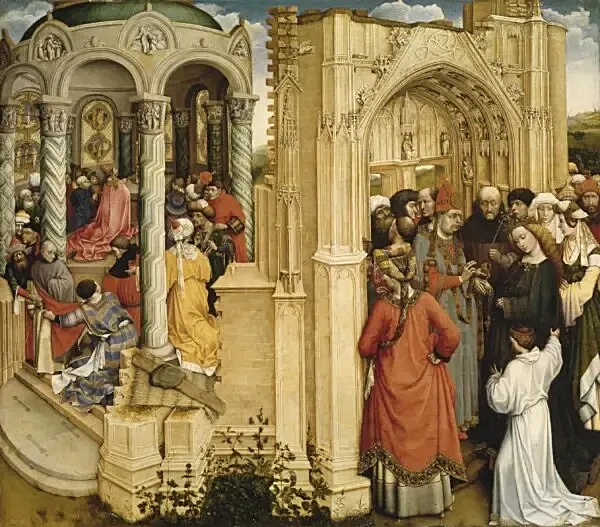The introduction of oil painting marked a significant breakthrough in the world of art. Compared to egg tempera, oil provided a better medium for capturing realistic details such as atmospheric conditions, surface effects, texture, and vibrant colors. From the Renaissance onwards, oil became the preferred method for fine art painting.

Campin, an influential artist during the early stages of the Northern Renaissance, worked in Tournai, Belgium, and oversaw a prominent workshop. Some of the paintings produced there, like The Met Cloisters’ esteemed Merode Altarpiece, were mistakenly attributed to Campin’s renowned student, Rogier van der Weyden. The identification of Campin’s work remains a complex and controversial matter.

Created around 1420 to 1430, this painting is characterized by creativity, naturalistic imagery, and intricate decorative details. The Betrothal of the Virgin is divided into two distinct scenes, distinguished by prominent architectural elements. Jos Juan Prez Preciado, curator at the Prado, describes how the painter’s creativity extends to both the iconography and composition. The Master of Flemalle introduced the powerful symbolism of dual architecture, a decision closely linked to the intended message and a testament to the innovative capacity of painting in the Netherlands during that time, in which he played a major role.
On the left side, a rotunda with a predominantly Romanesque style is depicted. It features characteristic rounded arches, stained glass, carved stone capitals, and imagined elements. The scene within this setting portrays the story of the miracle of the flowering rod. In the temple, all the widowers of Judea gathered to pray, and Joseph’s rod bloomed with flowers, symbolizing his role as Mary’s chosen husband.
Campin showcases the moment after this miracle. While the figures are positioned around the central praying priest, the focal action takes place at the temple’s doorway. Joseph, who concealed the staff under his cape, attempts to leave unnoticed but is stopped when two figures uncover the rod.


The stunning Gothic church interior reveals the Madonna and Child, illuminated by filtered sunlight streaming through clerestory windows and a side portal. This precise and nuanced illumination is made possible by the properties of oil paint. Van Eyck even captures the reflections of light on the church’s walls and floor. However, the light source is intentionally depicted in an unnatural orientation. The Museum explains that while Gothic churches typically faced east with their choirs, in our picture, the sunlight enters the church from the north instead of the south, defying reality. It represents not natural light but eternal light. Van Eyck, like Campin, skillfully used artistic license in service of his pictorial purpose.
Vividly portrayed, Mary stands monumentally tall, towering over the pilasters and other architectural elements. This deliberately exaggerated scale highlights her otherworldly presence. Behind her, a niche with lit candles houses a sculpture of the Virgin and Jesus, painted to resemble a real carving. The juxtaposition of a stone Madonna and Child with a human one creates an impression of a miraculous transformation brought to life.
The works of early Netherlandish painters never cease to amaze viewers. These artists utilized virtuosic oil painting techniques to depict expressive compositions with astonishingly lifelike details. The naturalism found in masterpieces by artists like Campin and van Eyck blurs the boundary between the depicted scene and the viewer’s reality, fostering a deeper sense of connection.
Discover more from Tension News
Subscribe to get the latest posts sent to your email.

